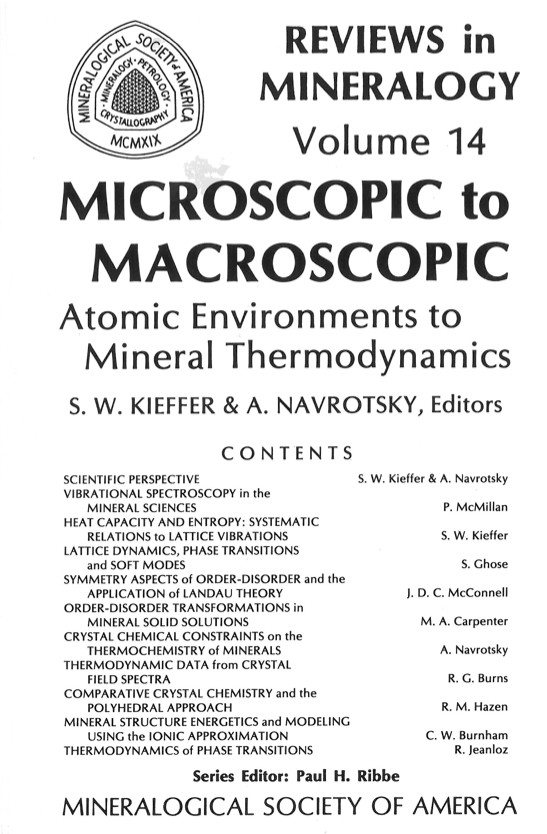
Mineralogical Society of America, Founded December 30, 1919
Order Publications Online (25% discount for MSA, CMS and GS members, except shipping)
MinPubs.org Pay-Per-View GeoScienceWorld Pay-Per-View

1985 i-x + 428 pages. ISBN 0-939950-18-9; ISBN13 978-0-939950-18-8
The purpose of this short course is to examine the relations among the microscopic structure of minerals and their macroscopic thermodynamic properties. Understanding the micro-to-macro relations provides a rigorous theoretical foundation for formulation of energy relations. With such a foundation, measured parameters can be understood, and extrapolation and prediction of thermodynamic properties beyond the range of measurement can be done with more confidence than if only empirical relations are used.
Mineral systems are sufficiently complex in structure and properties that a balance must be sought between rigorous complexity and useless simplicity. Eventually, even the most rigorous thermodynamic analysis requires simplifying assumptions in order to be tractable for complex minerals, and a firm foundation in the microscopic fundamentals should underlie those assumptions. The most fundamental questions of mineral physics and chemistry are "What minerals exist under given constraints of pressure, temperature, and composition, and why?" The macroscopic thermodynamic parameter defining mineral stability at a given pressure and temperature is the Gibbs free energy. The purpose of this course is to consider the microscopic factors that influence the free energy of minerals: atomic environments, bonding, and crystal structure. These factors influence the structural energy and the detailed nature of the lattice vibrations which are an important source of entropy and enthalpy at temperatures greater than 0 K. The same factors determine the relative energy of different phases, and thereby; the relative stability of different minerals. Configurational entropy terms arising from disorder also contribute to the energy and entropy. In transition metal compounds there are additional energy and entropy terms arising from the electronic configurations, leading to additional stabilizations, magnetic ordering, and, incidentally, color.
Organized by Sue Kieffer and Alex Navrotsky, the course was presented by the ten authors of this book on the campus of Washington College in Chestertown, Maryland. This was the second of MSA's short courses to be given in conjunction with meetings of the American Geophysical Union.
Title Page
p. i
Copyright
p. ii
Foreword
p. iii
Table of Contents
p. iv - x
Chapter 1. Scientific Prespectives
by Susan Werner Kieffer and Alexandra Navrotsky, p. 1 - 8
Chapter 2. Vibrational Spectroscopy in the Mineral Sciences
by Paul McMillan, p. 9 - 64
Chapter 3. Heat Capacity and Entropy: Systematic Relations to Lattice Vibrations
by Susan Werner Kieffer, p. 65 - 126
Chapter 4. Lattice Dynamics, Phase Transitions and Soft Modes
by Subrata Ghose, p. 127 - 164
Chapter 5. Symmetry Aspects of Order-Disorder and the Application of Landau Theory
by J. Desmond C. McConnell, p. 165 - 186
Chapter 6. Order-Disorder Transformations in Mineral Solid Solutions
by Michael A. Carpenter, p. 187 - 224
Chapter 7. Crystal Chemical Constraints on the Thermochemistry of Minerals
by Alexandra Navrotsky, p. 225 - 276
Chapter 8. Thermodynamic Data from Crystal Field Spectra
by Roger G. Burns, p. 277 - 316
Chapter 9. Comparative Crystal Chemistry and the Polyhedral Approach
by Robert M. Hazen, p. 317 - 346
Chapter 10. Mineral Structure Energetics and Modeling Using the Ionic Approximation
by Charles W. Burnham, p. 347 - 388
Chapter 11. Thermodynamics of Phase Transitions
by Raymond Jeanloz, p. 389 - 428